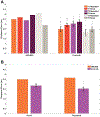Largely intact memory for spatial locations during navigation in an individual with dense amnesia
- PMID: 35367237
- PMCID: PMC9058227
- DOI: 10.1016/j.neuropsychologia.2022.108225
Largely intact memory for spatial locations during navigation in an individual with dense amnesia
Abstract
Spatial navigation and event memory (termed episodic memory) are thought to be heavily intertwined, both in terms of their cognitive processes and underlying neural systems. Some theoretical models posit that both memory for places during navigation and episodic memory depend on highly overlapping brain systems. Here, we assessed this relationship by testing navigation in an individual with severe retrograde and anterograde amnesia; the amnesia stemmed from bilateral lesions in the medial temporal lobes from two separate strokes. The individual with amnesia and age-matched controls were tested on their memories for the locations of previously seen objects relative to distal mountain cues in an immersive virtual environment involving free ambulation. All participants were tested from both repeated and novel start locations and when a single distal mountain cue was unknowingly moved to determine if they relied on a single (beacon) cue to a greater extent than the collection of all distal cues. Compared to age-matched controls, the individual with amnesia showed no significant deficits in navigation from either the repeated or novel start points, although both the individual with amnesia and controls performed well above chance at placing objects near their correct locations. The individual with amnesia also relied on a combination of distal cues in a manner comparable to age-matched controls. Despite largely intact memory for locations using distal cues, the individual with amnesia walked longer paths, rotated more, and took longer to complete trials. Our findings suggest that memory for places during navigation and episodic memory may involve partially dissociable brain circuits and that other brain regions outside of the medial temporal lobe partially support some aspects of navigation. At the same time, the fact that the individual with amnesia walked more circuitous paths and had dense amnesia for autobiographic events supports the idea that the hippocampus may be important for binding information as part of a larger role in memory.
Keywords: Allocentric; Amnesia; Episodic memory; Hippocampus; Lesion; Medial temporal lobe function; Spatial navigation.
Copyright © 2022 Elsevier Ltd. All rights reserved.
Figures








Similar articles
-
Close but no cigar: Spatial precision deficits following medial temporal lobe lesions provide novel insight into theoretical models of navigation and memory.Hippocampus. 2018 Jan;28(1):31-41. doi: 10.1002/hipo.22801. Epub 2017 Sep 26. Hippocampus. 2018. PMID: 28888032 Free PMC article.
-
Remote spatial and autobiographical memory in cases of episodic amnesia and topographical disorientation.Cortex. 2019 Oct;119:237-257. doi: 10.1016/j.cortex.2019.04.013. Epub 2019 May 13. Cortex. 2019. PMID: 31163312
-
Spatial navigation and memory: A review of the similarities and differences relevant to brain models and age.Neuron. 2023 Apr 5;111(7):1037-1049. doi: 10.1016/j.neuron.2023.03.001. Neuron. 2023. PMID: 37023709 Free PMC article. Review.
-
Specific, personally meaningful cues can benefit episodic prospection in medial temporal lobe amnesia.Br J Clin Psychol. 2016 Jun;55(2):137-53. doi: 10.1111/bjc.12095. Epub 2015 Sep 19. Br J Clin Psychol. 2016. PMID: 26384730
-
Memory dysfunctions.Handb Clin Neurol. 2020;174:93-110. doi: 10.1016/B978-0-444-64148-9.00008-9. Handb Clin Neurol. 2020. PMID: 32977899 Review.
Cited by
-
Spatial dissociation between recognition and navigation in the primate hippocampus.Sci Adv. 2024 Sep 20;10(38):eado7392. doi: 10.1126/sciadv.ado7392. Epub 2024 Sep 18. Sci Adv. 2024. PMID: 39292773 Free PMC article.
-
Multisensory input modulates memory-guided spatial navigation in humans.Commun Biol. 2023 Nov 14;6(1):1167. doi: 10.1038/s42003-023-05522-6. Commun Biol. 2023. PMID: 37963986 Free PMC article.
-
Combining patient-lesion and big data approaches to reveal hippocampal contributions to spatial memory and navigation.iScience. 2024 May 14;27(6):109977. doi: 10.1016/j.isci.2024.109977. eCollection 2024 Jun 21. iScience. 2024. PMID: 38947515 Free PMC article.
-
Age differences in spatial memory are mitigated during naturalistic navigation.Neuropsychol Dev Cogn B Aging Neuropsychol Cogn. 2024 Nov;31(6):1106-1130. doi: 10.1080/13825585.2024.2326244. Epub 2024 Mar 6. Neuropsychol Dev Cogn B Aging Neuropsychol Cogn. 2024. PMID: 38445641
-
Translating spatial navigation evaluation from experimental to clinical settings: The virtual environments navigation assessment (VIENNA).Behav Res Methods. 2024 Mar;56(3):2033-2048. doi: 10.3758/s13428-023-02134-0. Epub 2023 May 11. Behav Res Methods. 2024. PMID: 37166580 Free PMC article.
References
-
- Benton AL, Sivan AB, Hamsher K, Varney NR, & Spreen O (1983). Contributions to neuropsychological assessment. Oxford University Press, New York.
Publication types
MeSH terms
Grants and funding
LinkOut - more resources
Full Text Sources

